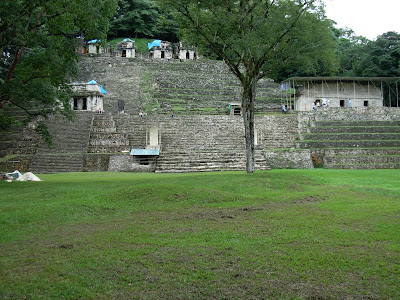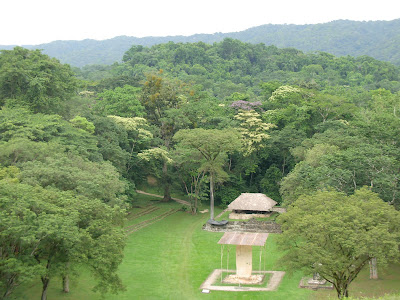


We saw more signs saying 'this is Zapatist Country' and more Mexican soldiers watching with loaded guns.

Naomi has a 'good kids club' that pays kids who ride along without any disruption, being paid according to the time of travel, or miles which are essentially the same. So we decided to also have a 'smart kids club' to reward kids who become aware of what they have seen and not just look and forget. So we initiated a payment schedule for the kids who could remember the states we have passed through and the sights we have seen there. We pay cash, pesos, for remembering the states we have passed through. Gusty did exactly as expected, nothing. His attention span will be measured as soon as they perfect the femta second measuring device. Yesterday he got a peso and had it less than a minute before he was asking what he could buy with a peso. Elena was a surprise, she took to it quickly. Of course Angela did it all, and eventually Virginia came through. Caleb dilly-dallied around a long time before doing anything.

We spent the night in Ococingo. Supper was huaraches, it used to mean the flip flop sort of foot wear but they used it to mean a shoe shaped tortilla with lots of good toppings, an open face device. For desert they had 'pay', their rendition of pie. I do not know why they did not use the English spelling, which in Spanish means 'foot'. If we can eat our shoes, why not our feet as well? It was the first pie I've seen in Mexico but I was to see it in other places once I looked.
The night was three blankets cold.
- Grandpa
I liked the Toniná ruin area; we’re out of the jungle now, and the land was reminiscent (to me) of Texas hill country – beautiful, yet comfortable, not stimulating. The hills were higher than Texas. The ruins were the most vertical that we’ve seen. Layer upon layer to be climbed. I think they were probably the highest from base to top, but we didn’t make it in time to go to the museum, so we didn’t get a perspective on what we were seeing.

The kids liked them a lot because of all the intricate passageways, and even a short, narrow tunnel that led nowhere. I declined their eager invitation for me to enter, but Edwin went down. He came back walking sideways, and quipping, “Now I know why Egyptians walk like this!”


We all climbed to the top, and saw the incredible view of the whole surrounding countryside, and the mountains dwarfed by our vantage point. Edwin and I took a picture in front of a rare grafitti that said “Noemi te amo.”

We were delighted with our hotel in Ocosingo. The new owner, who’s been there 2 weeks, enthusiastically shared his plans for the future: double the rooms from s15 to 30, parking in back and a restaurant. In the meantime we had to move taxis out of the very limited street parking, and walk to a taquería for dinner. We got 2 rooms of 2 and 3 beds, to the delight of the boys, who usually sleep on the floor. Each room had a balcony – one overlooking the main highway through town, which narrowed to one uncontrolled lane with a huge, gaping cavity on the side, and taxis darting in and out of parking on both sides. The back was more tranquil – just a new construction site for the church/disco across a side street.
However, I had my most miserable night of the whole vacation. The mattress seemed to be merely a box spring – hard and lumpy. Little creepy crawlies chewed on me, and when I got up the next morning I was spotted. One of my roommates went to the bathroom in the middle of the night, and, forgetting that there was no handle on the inside of the door, closed it rather snugly. When I heard the frustrated fingernails scraping at the door, I got up and pushed it open. But the worst of it was a faint but pervasive musty odor of mold. I sucked on a few cough drops to mitigate it, and was glad to vacate the next morning.
- Naomi










































